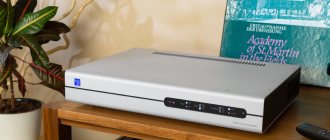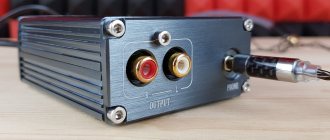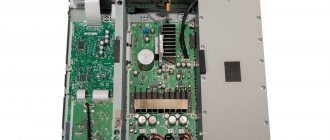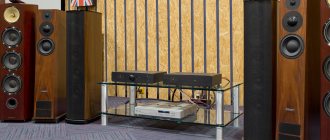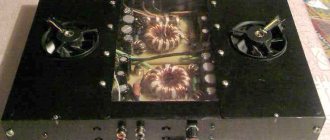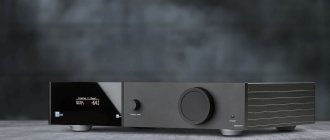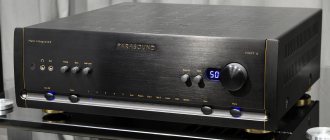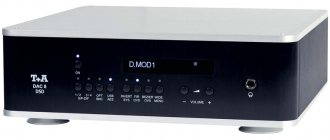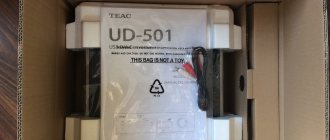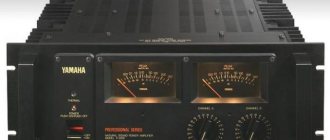Due to changes in the manufacturer's model range and lines, Stellar Strata is currently the only integrated amplifier in the PS Audio catalog. While getting to know this device, the thought constantly came to me: the “source” in this device is no less than the “amplifier”. So it turned out to be a very self-sufficient symbiosis.
There are a lot of unusual things here. It would seem, what can surprise an amplifier with a DAC on board now? Almost everyone produces such universal “all-in-one” models, but in our case everything is somewhat different.
Some kind of hybrid
Pleasant appearance - completely predictable for the Strata line. The body is rounded along the horizontal edges of the front panel, the on/off button in the form of a blue logo (like PS Audio network splitters), a miniature display and a rotating volume control knob. Plus a headphone jack. At first glance, there is nothing unusual.
PS Audio Stellar Strata
The back panel is already more interesting. One third of it is occupied by digital inputs, the other by analog inputs (including balanced and unbalanced pre-amp output), and another third by terminals for connecting speakers. By the way, the terminals are very nice, massive and high quality.
Of course, the digital part is more interesting. There is a connector for connecting to a network via twisted pair (the device also has Wi-Fi), a USB audio input, an optical input, a pair of coaxial inputs, and most importantly, an I2S input that looks like an HDMI connector. In general, this is a rare type of switching, but PS Audio uses it widely.
In this case, the DAC can operate via I2S in tandem with its own transport, which, in turn, works with both CD and SACD discs. Auxiliary switching includes control trigger connectors and a service USB port.
The DAC is built on the ESS Saber Hyperstream and can work with both PCM and DSD. The input signal is not subject to recalculation and is processed by a CPLD chip (a simplified analogue of an FPGA) as part of a proprietary circuit called Digital Lens, the main task of which is to reduce jitter.
PS Audio Stellar Strata rear panel
The I2S input is capable of accepting PCM up to 384 kHz, as well as DSD64 and 128. Coaxial inputs accept PCM up to 192 kHz, optical up to 96 kHz, and USB accepts PCM up to 384 kHz, and DSD64 and 128 in DoP mode.
When using the built-in streaming module, the “top bar” will be 24/96, and the services supported are Tidal, Qobuz, Spotify, Napster, iHeart Radio and DLNA on the local network. You can also pay attention to the DAC output stages operating in class A, as well as the fact that passive filtering is used.
In the signal path between the DAC and the power amplifier is a pre-amplifier - and it is quite unusual. Fully balanced circuitry, assembled without capacitors in the circuit and operating in class A. In general, this has been used for a long time with variable gain.
Next is the power amplifier. The manufacturer describes the circuit not just as Class D, but as something of a hybrid, called "AnalogCell" and having a fairly decent stated power of 200 W at 4 ohms per channel. If you look at the boards, it will become obvious where the PS Audio boards are in their characteristic purple color, and where the ICEpower 200AS2 output amplifier is - the markings are visible, no one is hiding anything.
So “AnalogCell” should rather be classified as a pre-amplifier, but it is assembled separately, and on the PS Audio board. You can see that all sorts of combinations of class A with class D are an option found in many manufacturers, but the implementation and sound are different for everyone.
Display, volume control and headphone output
It is also necessary to mention the manufacturer’s statement that, despite the circuit design, the device is made in such a way that the sound in nature is more similar to a tube one. In addition to the power amplifier for working with acoustics, there is also a separate class A headphone amplifier on board - with an output power of 300 mW at 300 Ohms and 3.25 W at 16 Ohms.
The body itself accounts for a very significant portion of the total weight of 9.5 kg. There are no toroidal transformers or impressively sized radiators here - at first glance, the filling looks more like a digital source or a preamplifier. However, from a practical point of view, everything is assembled neatly.
PS Audio Stellar Strata responds quite well to networkers
Network integrated amplifier PS Audio Stellar Strata
We have been testing such devices often lately, but this is a special case. The elegant body of this American device contains everything a modern music lover needs - a balanced analogue pre, an advanced DAC, an uncompromising streaming module and powerful final amplifiers. And, of course, a full set of unique PS Audio circuit solutions.
All that remains is to connect the speakers and listen to how it all plays.
Assortment of American PS Audio Inc. includes a wide variety of products that a true music lover can only dream of. There are sources, amplifiers, DACs, power conditioners, and cables for various purposes. And in each of them, the company uses original solutions invented by experienced designers and true audio enthusiasts.
The Stellar Strata integrated circuit, which appeared in the middle of last year, is essentially a symbiosis of two successful models - the Stellar Gain Cell DAC converter and the Stellar Power power amplifier. Both devices use interesting design solutions, and in our test device they are collected under one lid.
The proprietary feature of PS Audio is that the analog filtering here is passive, with minimal phase and transient distortion
First of all, this is a unique balanced preamplifier Gain Cell, in which all stages operate in class A, and no potentiometers, attenuators, or electronic switches are used to adjust the volume. Paul McGowan, chief developer of PS Audio, believes that all this inevitably spoils the sound. He developed a circuit in which the gain is set by the control voltage, i.e. used a principle similar to VCA (Voltage Controlled Amplifier), widely used in communications technology. This made it possible not only to reduce distortion and noise, but also to expand user capabilities - set the optimal sensitivity for each analog input, change the absolute phase of the signal, set the maximum possible volume level, or disable volume control altogether if the amplifier is integrated into a home cinema system.
The built-in DAC is based on a 32-bit ESS Saber chip with a proprietary HyperStream modulator. This converter is characterized by a wide dynamic range and minimal distortion at low levels. The proprietary feature of PS Audio is that the analog filtering here is passive, with minimal phase and transient distortions, and the output balanced stages operate in class A in the frequency range, which allows you to play high-resolution files without loss of information.
This is exactly what the rest of the tract is designed for. The input digital signal passes through a proprietary Digital Lens processing unit, built on a simplified FPGA matrix. It determines the resolution and format of the signal, after which reclocking is performed to reduce jitter. All this happens instantly and with maximum accuracy.
Data in I2S is transmitted via an HDMI cable through the appropriate port, and the source can be, for example, the SACD transport PS Audio PerfectWave.
The DAC has three digital filters with different characteristics. They are selected through the setup menu.
Filter #1, labeled Fast Roll-off, Linear Phase, is installed by default. It has an extended frequency band and the most analytical, monitor sound.
Filter No. 2 - Slow Roll-off, Linear Phase (slow roll-off, linear phase). This mode exhibits some loss of high frequencies and is not recommended for content with sample rates above 44.1 kHz.
Filter No. 3, Fast Roll-off, Minimum Phase, has a frequency response extended in the HF region. It is considered the most musical filter that many people prefer when listening to CDs.
Stellar Strata has six digital inputs. Three of them, I2S, Ethernet and USB-B accept PCM up to 384 kHz/24 bit and DSD64/128, a couple of coaxial ones up to 192 kHz, and Toslink optics up to 96 kHz. Data in I2S is transmitted via an HDMI cable through the appropriate port, and the source can be, for example, the SACD transport PS Audio PerfectWave. Let me remind you that the I2S protocol is good because it transmits audio data and clock pulses over different lines with a minimum level of crosstalk. In the same form, a 24/96 signal comes from the built-in streaming module via the internal bus.
All inputs can be renamed at your own discretion.
The scale of sound components is correctly conveyed: small details do not protrude, large ones do not dominate.
The final amplifiers here are also unusual. It is clear that in such a package without external heat sinks it is possible to obtain 2 x 200 W output only through pulse circuitry, but the manufacturer does not mention class D in the description; it only talks about output stages based on MOSFETs operating at high currents. Distortion does not exceed 0.01% at 1 kHz at a power of 37.5 W.
The front panel has a headphone output, the signal to which is supplied from a separate “analog” amplifier with low output impedance.
Access to online music services Tidal, Qobuz, Spotify, as well as NAS network storage is provided through the well-designed PS Connect App.
Operational adjustments are available from the standard remote control.
The manufacturer positions Stellar Strata with the slogan “Just add speakers,” but we supplemented the system with two sources - a MacBook Pro laptop and an AVM Audio Evolution CD 5.2 player. I wanted to evaluate the sound of the amplifier via USB and analog linear inputs. Speaker systems - anniversary bookshelf speakers Dynaudio Heritage Special.
We start with CDs when connecting the source with balanced cables.
The monitors sound energetic, bassy, with the right tonal balance. “Numbers” as such are not felt in the sound.
It looks like I will have to finally change my attitude towards class D amplifiers. Recently, pulse technology has advanced so much that it is almost impossible to recognize them by ear. The sound of the Stellar Strata is detailed, clear and musical, i.e. without schematics and synthetics. The scale of sound components is correctly conveyed: small details do not stick out, large ones do not dominate, but fit harmoniously into the overall picture. Reverberations are clearly audible on acoustic recordings - the diffusers are not overdamped, as is often the case in the D-class. Vocals are conveyed naturally, without metallic “notes”. The flow of music is smooth, Dynaudio monitors produce a perfectly balanced sound across the entire range with a rich lower range.
The sound resolution is high enough that the sound can be called contrasting, in combination with silk tweeters, the upper register is rich in detail, but these details are exclusively musical, not technical. This sound does not tire you, you can listen to it for a long time and with pleasure.
We connect the laptop via USB, having previously turned off everything unnecessary in the software player, and launch the tracks that are familiar to the smallest detail. The level has to be increased - digitally the Stellar Strata plays noticeably quieter. But neither noise nor other artifacts are noticeable either in pauses or in quiet places in the soundtracks. The sound is energetic, a little more contrasty than through the analog input. But without harshness, cymbals on “hot” recordings without sand - the top is still clean and clear. The monitors sound energetic, bassy, with the right tonal balance. “Numbers” as such are not felt in the sound.
You can quickly guess its presence if you play music from the cloud over a wireless network. But it is precisely to guess by completely insignificant signs - a slight loss of sound plasticity and enlargement of small strokes. And if I hadn’t listened to the Stellar Strata with wired connections before, I probably wouldn’t have paid attention to these little things.
Now briefly about digital filters. The default mode F1 is suitable for most sources, it gives an open and clear sound. If your speakers have too bright tweeters, for example, titanium or ribbon ones, you can “calm them down” by turning on F2. Conversely, with dim tweeters or in a dim room, F3 can be very useful. In our system and acoustically treated room, the difference between these three modes was not very noticeable.
The whole beauty of this integrated circuit, in my opinion, lies in the fact that the sound character of it is not similar to the vast majority of switching amplifiers. He has his own style, due to the non-standard construction of the sound path. This is the very case when the author’s approach to the design of equipment becomes the key to the musicality of the sound.
SYSTEM
- CD player AVM Audio Evolution CD 5.2
- MacBook Pro
- Dynaudio Heritage Special Speaker Systems
- Cables: interconnect Transparent Cables Super Balanced
- acoustic Transparent Cables Musicwave Plus
- network Transparent Cables Premium
PS Audio Stellar Strata
Manufacturer: PS Audio Inc. (USA)
www.psaudio.com
Analogue inputs: 3 x RCA, XLR || Analogue outputs: RCA, for headphones || Gain: 12 dB || Maximum output amplitude: 12 V RMS || Sensitivity: 5.3V RMS || Input impedance RCA/XLR: 47/100 kOhm || Output impedance RCA/XLR: 100/200 ohms || Boost frequency range: 10 Hz - 100 kHz (-3 dB) || Signal to noise ratio: -90 dBV (20 Hz - 20 kHz) || Channel Separation: >90 dB (1 kHz) || Rated output power (1 kHz, THD 1%): no less than 200 W (4 Ohms), no less than 100 W (8 Ohms) || Distortion: <0.01% @ 1kHz, 37.5W/4ohms || Minimum load resistance: 2 Ohms || Digital Inputs: I2S, Ethernet, USB-A (PCM up to 384 kHz, DSD64/128), Toslink (up to 96 kHz), 2 x Coax (up to 192 kHz) || Finish: black, silver || Dimensions: 432 x 305 x 76 mm || Weight: 6.1 kg || Price: 276,660 rub.
share
Tags: PS AudioPS Audio Stellar StrataExpert's Choice
That's another quest
The next important component for such modern digital-to-analog devices is software and compatibility. This is where Stellar Strata has mixed results.
The company has several devices (DirectStream DAC, DirectStream Junior, PerfectWave DAC) that have Roon tested and Roon ready status. But Strata does not yet have such a status - and I was not surprised when the current current version of Roon did not recognize the device on the network.
Rumor has it that control is possible using JRiver, Bit Perfect, Amarra and Pure Music, but these capabilities need to be dealt with separately, and I would, of course, like Roon compatibility - especially considering that the manufacturer already has positive experience.
The device’s own network capabilities include a streaming module and a native application. First you need to connect Stellar Strata with the network - there are not many difficulties here, but there are some peculiarities. For example, during the initial settings, the tablet connects to the device as a Wi-Fi point, and only then the application sees the device on the local network. But setting up with such a connection is not at all easy.
If you take a wired connection, there are no problems. But connecting the Stellar Strata to a wireless network is a little more complicated. I was unable to register the parameters from the application on the tablet. I had to do this from the menu on the front panel of the device - using buttons and the volume knob, which in this case turns into a navigation knob.
Imagine how to enter a complex Wi-Fi password using such manipulations? But that's how it works. However, this is not a function that needs to be accessed every day.
PS Audio Stellar Strata Internals
The device settings menu itself, displayed on the display on the front panel, is not very convenient. It is not visual, not intuitive, and at first you need to check the instructions to understand the logic of movement. Of course, you need to go through all this only once after the device has settled in the house, but the anticipation of “I’ll turn it on now and listen right away” will not be justified. However, this will only happen if connected via a network - the rest of the switching or operation in USB-DAC mode did not cause any complaints.
The application for iOS devices is also a quest. It exists, but it's not in the AppStore. They didn’t do enough work, they didn’t agree. How do we put it? We go to the PS Audio website, rack our brains, look for where it should be, find it, read the QR code, and lo and behold, the application is downloaded. However, iOS does not allow it to run. You need to go to the security settings, make permission in this regard - and then the application will become active.
The application looks a little empty, and even does not want to rotate on the tablet screen. However, the functionality is still present
On the right - the ability to assign names to several devices - the application can work with several devices at once. But in our local localization, “Lair” is not so relevant - of course, there should be “Den”. On the left are settings. With the network, I was not able to do everything from the application
Alarm…
The screenshot on the left is a hint on what to click and where. In fact, nothing is clear. The screenshot on the right is a radio service for a streaming module - the most logical application. Until new software and firmware appears, it’s more logical to transfer the rest to a computer or other devices
It also works specifically. Inside there is a certain set of settings, most of them unusual - for example, a programmable alarm clock. But the interface is generally simple, and I limited myself to using the streaming application only for Internet radio.
Coupled with the fact that the top streaming limit here is 24/96, using the device in USB DAC mode paired with some third-party software is much preferable. Especially if you need to combine streaming and local file library with one application.
And the streaming component... I would say this - now it’s more likely not there than it is. But let's remember that PS Audio is a company that entered the market of devices with streaming support a very long time ago, and in its past and present there are very remarkable and well-deserved devices.
I think that in the case of Stellar Strata, in the future everything will be decided by firmware and software updates. And of course, I would really like to see compatibility with Roon. For now, we will consider the device as an integrated amplifier with a DAC on board - and, to some extent, with a streamer.
Listening
The main test was carried out in the case of using an amplifier and a built-in DAC with a USB connection, but you should also not forget about the possibility of connecting the usual disk transport. And switching via I2S - if, of course, you have something to connect in this way. But I still wanted to focus on using it in conjunction with a computer, especially since I have all the software there, an extensive music library on the server, and streaming services.
To start, I played a recording of “The Best of the Dial Years” by Charlie Parker and Miles Davis. The sound character is detailed, with a noticeably pronounced effect of attractiveness, a certain immersion in the sound. The old recording sounds rather bright and, indeed, with some vintage tube character.
The intelligibility is not bad - and it seems that it is specially emphasized, due to which the sound is perceived as interesting and multi-component. The presentation is expressive - both in the middle and at the top. There is no point in judging low frequencies from this recording, so we will pay attention to them later.
Here the PS Audio Stellar Strata has a DAC, a streamer, and a preamplifier
With seemingly perceived brightness, the sound is not sharp, but even softened - bright, but warm. The monophonic sound also turned out to be unusual - the elaboration in depth is not so noticeable (although it is present), but rather a very wide panorama. Of course, it's not stereo, but the width of the sound is impressive.
The next disc is Colin Vallon Trio “Rruga”. There is good rhythm and elasticity, the detail is felt higher than it actually is. The presentation is not exactly holographic, but some pretense is obvious. At the same time, all this is unusually mixed with a degree of warmth and softness. The result is a slightly psychedelic atmosphere, filled with rich but muted colors.
The velvety airy wide stage also contributes to this perception. The mid-upper range seems slightly emphasized, on the other hand, and the volumetric bass is proportionate. It seems that the entire sound as a whole, throughout the entire range, is somewhat emphasized and presented more textured than usual.
In general, everything turns out to be emotional, but the nature of the emotions rather goes a little into noir, into light psychedelia, completely devoid of bravura or deliberate joy. It is clear that the device has an unusual character and its own interpretation of sound. And already at this stage it can be noted that the sound can be described in very different ways, but definitely not as boring or pedantic.
ICEpower 200AS2 as a power amplifier
Next I played Diana Krall’s much-loved album “When I Look In Your Eyes.” And I must say, listening for 20 minutes did not send me into a deep sleep. The sound is cheerful, with savoring after-sounds it seems less monotonous than usual. Emotions are perceived brighter, but no puppy joy is observed. The warmth is present, but it is unobtrusive, the vocals are well developed and not exaggerated relative to the rest of the sound.
The piano parts have a slight touch of synthetics, or rather, a light ringing color with an emphasis on halftones, but no more. And in principle, there is much less synthetics in the sound than I expected. Instead, there is warmth similar to a vintage lamp, moderate softness and some obvious “fluffiness” of the sound and the volume that this sound portrays. Plus good rhythm - confident, but not arrogant.
On the recording of Eddie Higgins Quartet Featuring Scott Hamilton “Smoke Gets In Your Eyes” you can hear the already familiar presentation of the device itself, but the style of performance and recording of Venus Records is also perfectly recognizable. In general, the sum is obtained without a bias in one direction or another - everything worked out harmoniously.
First of all, I liked the rhythm. It is always emphasized, but at the same time soft and delicate when needed - or fast and biting, if needed otherwise. The dynamics are not just good - they are emotional.
The bass is very good in terms of filling - and it is not formally simplified. The detail is still the same, slightly emphasized by after-sounds and textures, which very well masks the fact that the most subtle shades and nuances are formalized and simplified. One seems to replace the other, and overall the sound does not seem rustic or faded. And I didn’t expect full-fledged detail - the kind that I’m used to - here, but in practice this detail costs much more.
The presence of warmth in the sound is not annoying, although I do not like warmth. It’s just that here it’s of such a nature that it’s in moderation – not too much and not too little. The integrity of the picture does not fall apart - everything is in its place and in well-combined proportions.
Dimmu Borgir's album “Puritanical Euphoric Misanthropia” showed that the tract could cope dynamically even with such material. But where there is a synthesizer sound on the recording, it is very noticeable, and the sound becomes a little comical, toy-like.
Otherwise, it’s fast, energetic, playful, with a good scene and good detail. And quite emotional, but somewhat more joyful than it could have been on average. And here it’s difficult to say how well it fits with specific music. But according to formal criteria - better than expected.
Standard PS Audio Stellar Strata remote control
Finally - Bach's Brandenburg Concertos. The device reproduces the difference between high-resolution and 16/44 quite clearly; the sound has good resolution and decent dynamics.
In terms of detail, you can find a number of minor simplifications, there is a little bit of synthetics in timbre, but this is barely noticeable, because the general style very successfully masks all this, and the artificial “lampiness” clearly neutralizes the presentation in such a way that everything as a whole is perceived quite naturally. Although with an obvious amount of coloring. The scene turns out to be large-scale, airy, with fairly bright and clearly outlined images, without lethargy or vapidity.
Separately, I would like to say a few words about the headphone amplifier. I really liked the way it works. The sound is neutral, detailed and dynamic, with the slightest touch of synthetics, which, however, you stop noticing after a few minutes of listening.
PS Audio Stellar Gain Cell DAC and Stellar M700 monoblocks
In the American magazine “The Audio Beat” (June 22, 2018)
A review of the audio system consisting of the PS Audio Stellar Gain Cell DAC and a pair of Stellar M700 mono amplifiers has been published.
Author Guy Lemcoe was delighted with the sound of this combination of components and wrote: “The PS Audio Stellar DAC and M700 amps took my system to a level that, with some recordings, was eerily close to the real thing.” “The PS Audio Stellar DAC and M700 amplifiers took my system to such a level that some recordings sounded eerily close to reality.” “Paul McGowan and his Boulder team should be beaming with pride at the superior sound of these components. First-time audio system buyers, as well as those looking to upgrade, should definitely give these electronic components a listen before they try to foolishly spend their hard-earned money elsewhere. Add a pair of properly sized speakers (a good local dealer will help you do that), plus a decent source, and you've got one hell of a music system that will put a smile on your face every time you fire it up. For me, real sonic revelations regularly emerged with these elegant components, highlighting more of the nuances and soul of the chosen musical recording.” “At the heart of the Stellar Gain Cell DAC is an amazing DAC designed by Bob Stadtherr. Based on the industry-leading Sabre32 bit Hyperstream chip architecture, the Stellar DAC features a fully balanced Class A output stage with multiple power supplies, independent jitter-rejected input, DSD, I²S reception, and asynchronous USB.” “After replacing my trusty Emerald Physics EP100.2SE stereo amplifier with a pair of M700 monoblocks and my Emotiva USP-1 preamp with a Gain Cell DAC, among the first things I noticed was the solidity, consistency and smooth musicality of the recordings' presentation.
These amazing Class D amplifiers did their job, laying a solid foundation for the bass, above and beyond which a huge soundstage extended (if it was "captured" during recording). The mids and highs were flawless and easy on the ears. Listening to record after record, I swear I could hear previously unheard details in the tracks being played." “Overall I couldn't fault the sound of the Gain Cell DAC - its neutrality and honesty were captivating, making for a compelling listening experience. Throughout the time I spent with it and a pair of M700s, I always felt like they were in complete control of any music fed to them, in any format. From the subtle nuances of an unaccompanied lute, to the bombast of a symphony orchestra playing at full blast, to the effortless drive of dub or the pulses of electronic music, I never once felt devoid of any emotion, rhythm, dynamics or detail in the music. Whether it was planar, stand-mounted, or floor-standing speakers, I knew I would always be rewarded with music without noise, artifacts, or boredom. Used together, the Gain Cell DAC and M700s represent a smart, cost-effective entry into the leading upper tier of high-end audio. Of course, there are components that cost much more, offering perhaps better sound, but I seriously doubt that any music lover will be unhappy with the capabilities of this duo, its sound or anything else.
conclusions
Perhaps this is one of the very good options for devices operating in class D. The main thing is that the synthetics are almost invisible, and the color really looks like a lamp. Even if there is warmth and softness in it, the sound is cozy, friendly and even cute, but without cloying. There seems to be a lot of everything, but in moderation.
This is not a standard neutral sound. But that’s exactly what he intended! And if you don’t try to get attached to these criteria, then you get a very universal device with a full-fledged digital source on board, as well as with its own brightly individual sound character, unlike other equipment.
